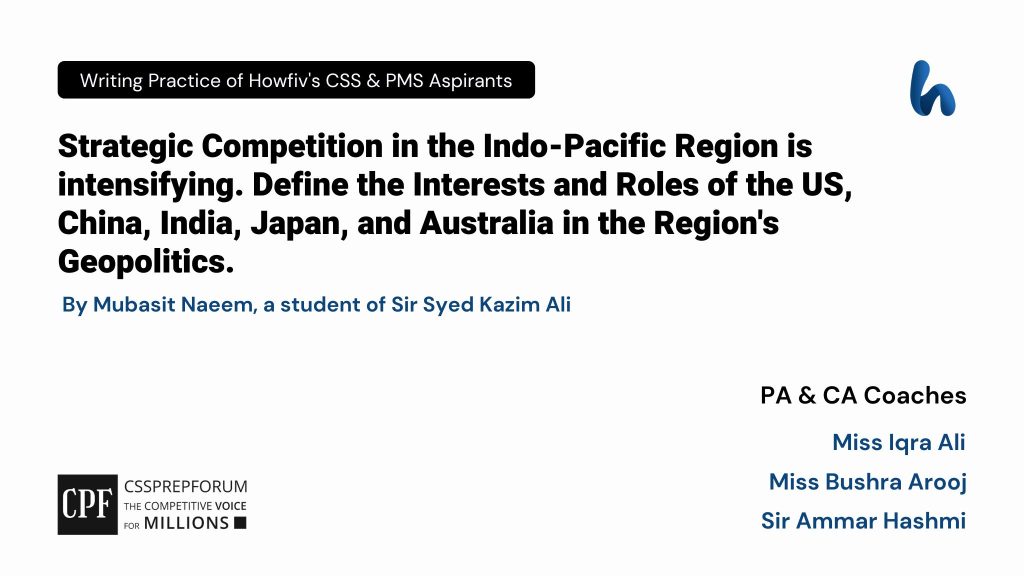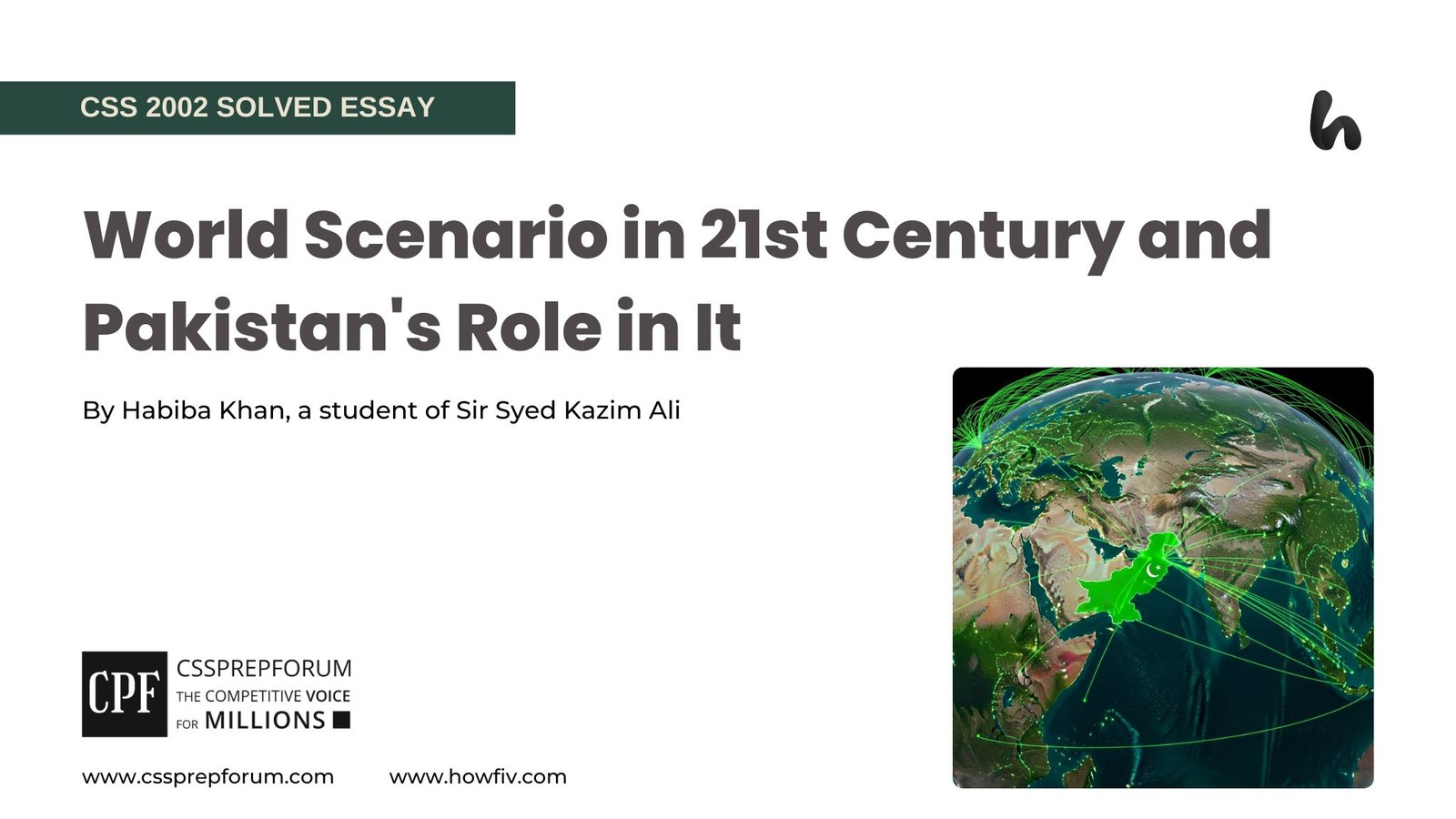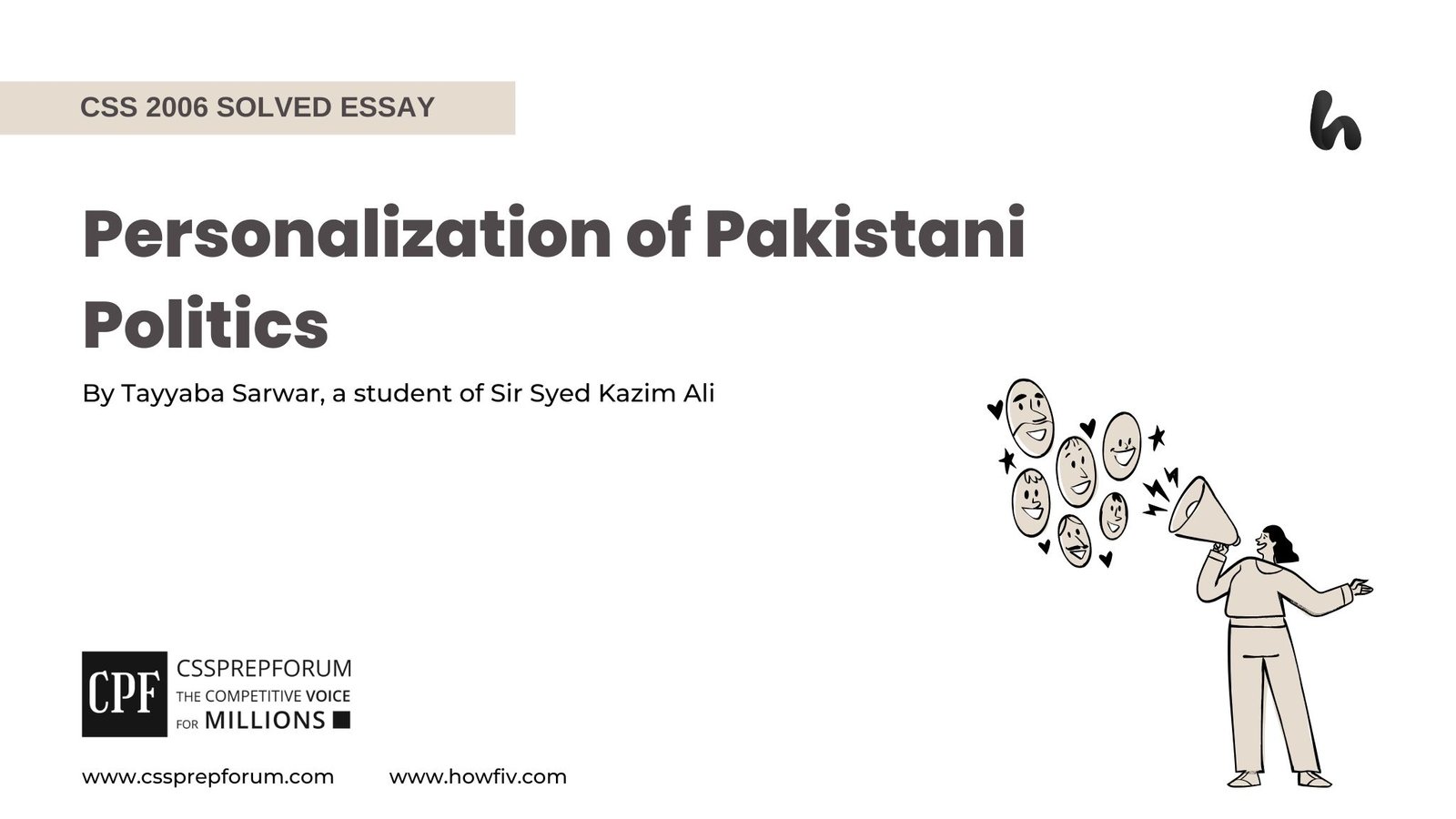CSS Current Affairs | Strategic Competition in the Indo-Pacific Region
The following question of CSS Current Affairs is solved by Mubasit Naeem under the supervision of Howfiv’s Pakistan Affairs and Current Affairs Coaches. She learnt how to attempt 20 marks question and essay writing from Sir Syed Kazim Ali, Pakistan’s best CSS and PMS English essay and precis teacher with the highest success rate of his students. This solved past paper question is attempted on the pattern taught by Sir to his students, scoring the highest marks in compulsory and optional subjects for years, and uploaded to help aspirants understand how to crack a topic or question, how to write relevantly, what coherence is, and how to include and connect ideas, opinions, and suggestions to score the maximum.

Introduction
The Indo-Pacific region, stretching from the eastern coast of Africa to the Pacific Ocean geopolitical strategies, where the interplay of great world powers, the logic of balance of threat, nurturing side of geopolitics, the epicentre of world 85% trade and strategic realignment, shapes the regional order. The United States of America (USA), a renowned world hegemon and principal proprietor of the Liberal system, is seeking to ensure primary key player in this region with the theory of open and accessible maritime routes for all against China’s assertive expansion and influence, which is characterized by the great initiative of Belt and Road (BRI) initiative, pearl of string strategy, and Nine dash claim in South China sea. India, an emerging economic power in South Asia with a long extended coastal line and leveraging its strategic autonomy economic doctrine, strives to reinforce its maritime influence and counterbalance China’s growing clout. Coming to the eastern nation, Japan, famous for its peace efforts and economic might, has adopted a proactive pacifism approach to safeguard its national security and trade routes through which it manages 90 % of its economic activities, countering emerging influencing red flag nation (China). The land of kangaroos, Australia, has dived into the US-China rivalry pool, which is characterized by a great number of complexities. Canberra has directed its country towards the USA in defence and economic stability through AUKUS, QUAD, and other defence pacts, and it has fostered regionalism by developing relationships with ASEAN countries, Japan, and, most importantly, India. These strategic manoeuvres reflecting the dance of great power and regional countries around their interest, diplomacy, and security clashes have made the Indo-Pacific theatre a critical hot spot to play at significant risks that influence the world through its ripple effects.
What are the roles and interests of USA, China, Japan, India and Australia in the geopolitics of the Pacific Region?
- Interests and roles of the USA in the Indo-Pacific region:
The United States of America, a proclaimed global power and cradle of a liberal international system, has played a pivotal role in the geopolitics discourse of the Indo-Pacific. Through the lens of hegemonic stability theory, the USA seeks to ensure free and open Indo-Pacific Sea lanes, particularly in the contested South China Sea, thereby safeguarding its status as a hegemon, influencing Southeast nations and protecting them against China’s expansionist ambitions. The USA, lauded for driving prosperity, bolstering global security, and supporting Taiwan’s autonomy, has made its necessary presence in this region by mobilizing 60% of surface ships and developing naval and air bases. Furthermore, the USA put forward the “Pacific Deterrence Initiative” to counter China. Through this initiative, Washington has signed many agreements like QUAD, AKUS, a Mutual defence treaty with the Philippines, the 1960 security treaty with Japan, the Taiwan relation Act 1979 to protect Taiwan from Chinese aggression, and a defence agreement with South Korea. Next, to build connections within and beyond regions and build resilience, the USA has given 900 billion dollars in aid to ASEAN nations and Australia, as the Stockholm International Peace Institute (SIRI) reported. Last but not least, Washington has pursued multilateral frameworks such as the Comprehensive and Progressive Agreement for Trans-Pacific Partnership (CPTPP) and robust bilateral agreements for economic well-being and economic gain. This multifaceted approach encapsulates Washington’s enduring interest in regional stability, economic prosperity, and containment of China’s expansion influence, solidifying its role as a principal architect of Indo-Pacific strategic architecture.
- China’s interest and role in the Indo-pacific region
China, a dragon ready to claim its throne in world politics, has made engagements in the Indo-Pacific region driven by economic ambitions, strategic imperatives, and geopolitical aspirations, reflecting its emergence as a global stakeholder next to Washington. First, seeing its economic interest, Beijing does almost all of its economic activities from eastern ports in the East and South China Sea. It is a permanent threat due to the American presence in this region. As a result, Xi Jinping’s government has the Belt and Road Initiative (BRI), a mega infrastructural connectivity project, a marvellous project including seaports (making a string of pearl), railways, and road connectivity to get involved in the alternative routes of trade. Strategically, the South China Sea, a crucial maritime corridor for global trade and blessed with abundant natural resources, is important to China. She asserts its dominance by giving a “nine-dash line” as its maritime boundary, promoting the “One China Two system policy” in the case of Taiwan and constructing artificial islands for militarizing key outposts. This assertive posture solely serves to project power, secure sea lanes, and provide a strategic buffer against perceived threats from other regional actors such as the USA. According to the analyst, China is using “Chequebook diplomacy” to engage other countries in the Indo-Pacific region through economic ties and extravagant loans, increasing their dependency on China. In the same context, China has made an offer to join CPTTP. In conclusion, China is using both hard power, military expansion and soft power through economic and diplomatic engagements. By advancing its interests and strengthening its role, China is posing a threat to Washington’s hegemony and changing world order, positioning itself as the centre of power source for world politics.
- India’s role and interest in the Indo-Pacific region
India, a new economic emerging power in South Asia, is worried about newly Hegemon in its backyard. This has imposed a crucial threat to Indian sea lanes routes. Having a history of conflict with China in matters of the border between the two countries and being a close ally of the USA aggravates India’s position at a harsh end with China. Furthermore, China’s closeness with its adverse enemy, Pakistan, is the bone of contention in the relationship between India and China. New Delhi is advancing in playing an important role in the Indo-Pacific region to protect its interests and emerging economic power. The most important initiative, QUAD, a four-country alliance especially to enhance naval power, expertise, and cooperation, is actively performing its function. Next, to counter China’s string of pearl strategy, the Modi administration has put forward a “Necklace of Diamonds” strategy. In this strategy, New Delhi is ready to incorporate Seychelles and Mauritius islands, Duqm port in Oman, Saban Dong port at the northern entrance of Malacca strait, and Changi naval base in Singapore. Moreover, to mitigate China’s influence, the Modi administration has inked many agreements and partnerships such as a crucial partnership with ASEAN, an Acquisition and Cross-Cross agreement with Japan, vision SAGAR (security and growth for all regions), multi-sectorial technical and Economic Cooperation (BIMTEC), forum for India-Pacific Islands cooperation (FIPIC), and project Mausam. In this scenario, it is evident that New Delhi is ready to impose its influence with total capacity with the support of the USA and other anti-China countries against Xi Jinping’s vision of the new Lord of the world.
- Interest and role of Japan in the Indo-Pacific region:
Japan, a nation that heightened its glory after World War II, remained far away from the patty politics of Indo-politics till a threat knocked at its door. East China Sea is the main maritime route for Japan to operate trade, and Japan uses the other side of the Pacific Ocean as a major sea lane for trade. Beijing’s presence in these routes is a severe concern for Tokyo. Sharing the same region with North Korea, Russia and China claim that Senkaku Island is imposing a security threat to Japan. Moreover, Xi Jinping’s influence in this region challenges Fumio Kishida’s government’s grip over it. According to Stephan Walt’s theory of “Balance of Threats”, entities make alliances and agreements with other nations against powerful ones to balance the threat. Tokyo works on the same theory and has made its role in this region significant in countering potential threats from Beijing. Tokyo is impressively proprietor of the “Free and Open Indo-Pacific Strategy” to secure its sea lanes. Furthermore, Tokyo made a significant approach to naval power enforcement and signed many accords with other nations such as Japan, Australia, US (JAUS) naval deployment, the Common Indo-Pacific agreement between Japan and Australia and proposed QUAD. To bolster its security and defence, Tokyo has already inked an agreement with the USA, and it has also documented a Reciprocal Access Agreement with Australia and an Acquisition and Cross-Cross agreement with India in sharing in formation and defence warlords. Next, Tokyo proclaimed the confluence of two seas and routed the Japan-India-Arabian Sea, so it announced the Asia-Africa Growth Corridor (AAGC) in 2016. In conclusion, the rising threat of China in maritime security and national security and its exercise of influence have made Tokyo go for the pool of rivalry with China and join hands with the USA and its allies in this region.
- Australia’s interest and role in the Indo-pacific region
In 2009, Rudd’s government issued a Defense White Paper, which made Canberra an official entry from the existing Pacific region to a more diverse Asia-Pacific region, including China. Australia, an old ally of the USA, built a relationship with China with a warm welcome on mutual interest. Advancing with time, a clash of interests between China and Australia accused China of national-level power outrage by cyber attack has taken both countries to a dead end. Beijing’s interests in access to fishing zones, ports for its fleet and possible mining of sea beds have made XI Jinping dock at Papua New Guinea and small islands like Vanuatu, Fiji and Solman islands, approximately 200km from Australia. It seriously threatened Australian security and was an easy way to espionage over its territory. To counter this, Canberra worked for different cooperation. It successfully agreed to play a role in the Indo-Pacific region, like Australia, United Kingdom, United States (AUKUS) nuclear submarine deal, QUAD, and the Five Intelligence Network for Intelligence sharing between Australia, the United States, New Zealand, Canada, and the United Kingdom. It also proclaimed an “Australia Pacific setup policy” to finance small island nations in the Pacific Ocean to blur Chinese influence in this region. In a nutshell, as an ally of the enemy of China, Australia has adopted an anti-China policy to assert its influence in this region with the support of major world powers.
Critical analysis
Critically, Indo-Pacific theatre is becoming the playground for major emerging powers to exercise their strength majorly against China. According to the Greek Philosopher Thucydides, a rising power is destined to clash with the existing power. Therefore, the Beijing Consensus challenging the Washington Consensus is a clash of new emerging powers with existing powers. Moreover, the realism theory claims that there is no government at the international level, and countries have to create deterrence for their survival. Applying this, India, Japan, and Australia are managing to bring their security and economic gain for survival in an anarchic world. The USA is struggling to maintain its hegemony; China is ready to flex its muscles to show its potential; India’s strategic autonomy pushes it to play a vital role in world theatre. Australian security interests have made him a key player in this game, and Japan, known for its pacifism, is now establishing ties with another world to counter China
Conclusion
The complex interplay of interests and roles of significant powers shapes the Indo-Pacific’s strategic landscape. The U.S. seeks to maintain its importance through military and economic means, while China pursues a revisionist agenda through the BRI and military assertiveness. India and Japan are pivotal balancers, enhancing their strategic partnerships and regional engagements. Australia’s hedging strategy exemplifies smaller powers’ challenges navigating excellent power competition. The future of the Indo-Pacific will hinge on how these actors reconcile their ambitions with the need for regional stability and cooperation amidst evolving geopolitical dynamics.

CSS Solved Past Papers’ Essays
Looking for the last ten years of CSS and PMS Solved Essays and want to know how Sir Kazim’s students write and score the highest marks in the essays’ papers? Then, click on the CSS Solved Essays to start reading them.
CSS Solved Essays
CSS Solved Islamiyat Past Papers
Want to read the last ten years’ Islamiyat Solved Past Papers to learn how to attempt them and to score high? Let’s click on the link below to read them all freely. All past papers have been solved by Pakistan’s top CSS Islamiyat coach having the highest score of their students.
CSS Solved Islamiyat
CSS Solved General Science & Ability Past Papers
Want to read the last ten years’ General Science & Ability Solved Past Papers to learn how to attempt them and to score high? Let’s click on the link below to read them all freely. All past papers have been solved by Pakistan’s top CSS GSA coach having the highest score of their students.
CSS Solved General Science & Ability












